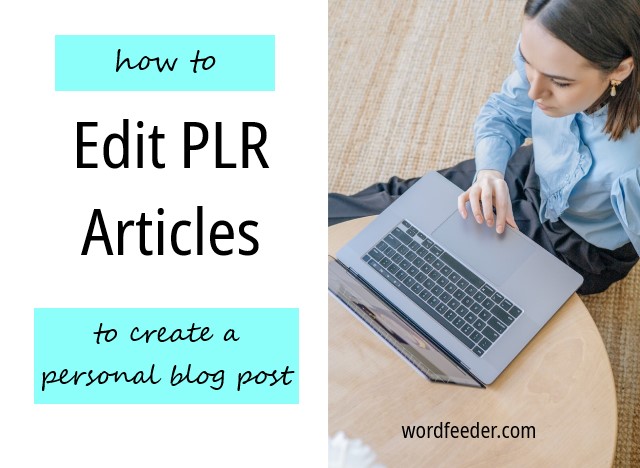Editing Your PLR to Create a Personal Blog Post

Last time I discussed PLR editing, I shared a before and after with you. Today I'm going to explain a really effective method for editing PLR to make it your own.
So, you just bought an article and you're going to publish it on your blog. Here's what to do.
Scan it. First scan the article that you purchased, to mentally take it in. Next, immediately begin relating the material to your own life. I mean in your head, not in the actual document.
Personalize. Once you're done scanning, it's time to personalize the content. Look at the first paragraph of the article you bought. Then, if it doesn't sound particularly interesting, scrap it. Yes. I give you permission.
If the intro's strong, hold onto the content. You can fit it in elsewhere in a minute. For now, you're going to write a fresh intro. Your intro should speak directly to your reader, as though you're having a conversation with him or her.
So, let's say the article's about basement flooding. You might ask your reader, "Are you freaking out over a flooded basement?" Or, "Not sure what to do about a flood in your basement?"
Or, if you want to start with a personal anecdote, you can say something like, "My husband and I recently faced some basement flooding problems."
Develop your intro with just a few sentences. "Are you freaking out over a flooded basement? Although this may seem like a catastrophic event, water in the basement is fairly common-- so try not to panic. Below, I've listed some steps to remediate the situation quickly, before mold growth becomes a problem."
That's a sample - you can say whatever is relevant to your own story, obviously. But the point here is that your intro should be purely you, and sound nothing like the article that you purchased.
Massage the main points. Next, take a look at the main point of each supporting paragraph. If you feel that whatever was said makes sense and is relevant, keep that sentence or idea, but personalize what comes after. After each point made, develop it by inserting a tip of your own, or a personal anecdote.
Insert active voice. Most PLR tends to be written in a passive voice. Example: "A wet-dry vac is highly useful for cleaning up water in the basement." Include a certain amount of passive voice if it flows with the rest of the paragraph. But too much passive voice sounds wishy-washy and overly wordy. Beef up the writing replacing passive voice with active verbs. "Use a wet-dry vac to suck up those puddles" employs active voice.
Conclude with a promo. For the article's conclusion, either retain the one that came with the PLR article you bought... or, replace with a brief product recommendation. So in keeping with the wet basement example, maybe you're already selling an ebook about basement flood remediation. Here's where you'll add a few sentences about the ebook with a link to the sales page. Or, add a your Amazon affiliate link to a popular type of wet-dry vac, with a few lines of copy.
Once you get good at this, you'll be able to tap out a brand new blog post in less than half an hour, using PLR as the basis for your article.
